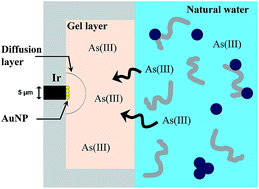Antifouling membrane integrated renewable gold microelectrode for in situ detection of As(iii)†
Abstract
Arsenic in the environment is of a global concern because of the widespread, chronic poisoning found in a number of countries and affecting large populations. Robust and sensitive analytical tools capable of direct, continuous in situ As(III) sensing is therefore of prime interest for As health risk assessment. For this purpose, we have developed here a microelectrode consisting of a gel integrated renewable gold nanoparticles plated iridium-based microelectrode (Au-GIME). The gel minimizes fouling problems by hindering diffusion of organic matters and inorganic colloids/macromolecules toward the sensor surface. Square Wave Anodic Stripping Voltammetry (SWASV) was used to characterize (i) the kinetics of As(III) diffusion in the agarose gel as a function of the gel thickness, (ii) the analytical performance of the sensor in synthetic and natural waters, and (iii) the influence of the temperature on the arsenic stripping peak current intensities. An evaluation of direct environmental application was performed in freshly collected lake water samples and validated by ICP-MS after separating As(V) and As(III) with an ion-exchange resin. The results reveal that the Au-GIME fulfills the requirements for direct measurements of (oxy)anions in freshwaters, i.e.: a reproducible mass transport of arsenite species in the gel; a gel equilibration time varying with the thickness of the gel in accordance with theory; a temperature effect on the SWASV As(III) signal intensities following a Arrhenius behavior and thus readily corrected using a factor defined in laboratory; and a nanomolar detection limit at pH 8.


 Please wait while we load your content...
Please wait while we load your content...